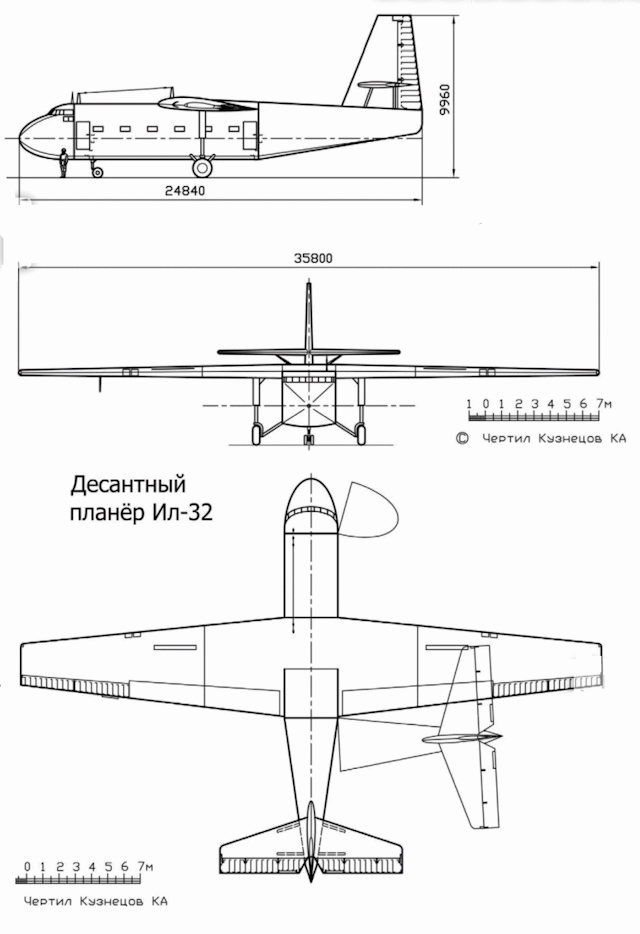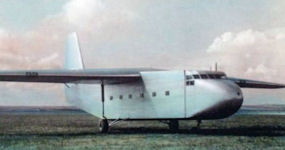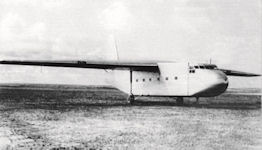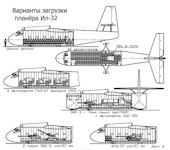IL-32 airborne cargo glider
Airborne cargo gliders were created in the Soviet Union even before the Great Patriotic War. In 1942, the 20-seat airborne glider KC-20 was designed by D.N. Kolesnikov and P.V. Tsybin. In 1944-1945, P.V. Tsybin created the Ts-25 landing glider with a carrying capacity of 2500 kg, and somewhat later, A.S. Yakovlev created the Yak-14 landing glider.
The IL-32 airborne cargo glider was designed by S.V. Ilyushin Design Bureau and built in 1948 on instructions from the Air Force. The IL-32 glider in terms of carrying capacity and cargo compartment size was significantly larger than the gliders created before in our country, and was intended for the transportation of various equipment and bulky goods with a total mass of up to 7000 kg or a landing force of up to 60 people. The glider with a flight weight of 16,600 kg was designed for towing aircraft of the Il-18 type (built in 1946) or Tu-4 .
According to the scheme, the Il-32 glider was an all-metal monoplane with a high mounted wing. The fuselage was of a rectangular cross-section 3.2 x 4.15 m with an unpressurized cargo compartment 2.6 m high, 2.8 m wide and 11.25 m long (excluding hollow fore and aft fuselage) with a cargo metal floor. Entrance doors are located on the starboard side at the beginning and at the end of the cargo compartment. The nose and tail of the fuselage were made recline to the side. The cockpit was designed to accommodate two pilots. The glider wing was two-spar, with an area of ??159.5 m2, an elongation of 8, a sweep of 3 °, a relative thickness of 18% on the side and 10% at the ends of the wing, it was equipped with simple rotary flaps, ailerons, as well as spoilers located in front of the flaps.
The wing structure of the IL-32 is two-spar, the wing area is 159.5 m², elongation is 8, sweep is 3 °. The relative thickness of the wing along the side is 18%, at the ends of the wing - 10%. The wing consists of simple rotary flaps, ailerons and spoilers, which are located in front of the flaps. High aerodynamic qualities of the wing and efficient mechanization have contributed to obtaining good flight and takeoff and landing characteristics. The plumage included a fixed stabilizer, which was fixed on the keel with the help of two lower struts. The rudders and heights had a metal structure with linen sheathing.
The chassis of the glider is not retractable in flight, tricycle. Due to the telescopic design of the main racks, the IL-32 performed a “squat” to the ground, which, together with the reclining tail and bow parts, helped to speed up and simplify loading and unloading operations. At this moment, the floor of the cargo compartment above the ground towered only 650 mm. Side ladders were attached to it, along which military self-propelled equipment was lowered or lifted under its own power.
Due to the high aerodynamic quality of the wing and efficient mechanization, good flight and airborne flight characteristics were obtained. The plumage was performed with a fixed stabilizer mounted on the keel and supported from below by two struts, elevators and directions — metal construction with linen sheathing. The glider is equipped with a tricycle landing gear, not retractable in flight. The main landing gear supports of the telescopic design provided the glider “crouched” to the ground, which, in combination with the bow and tail parts of the fuselage that leaned toward the side, greatly simplified and accelerated loading and unloading of wheeled and tracked vehicles, as well as various loads. The height of the cargo compartment floor above the ground was about 650 mm. On the front and rear of the cargo compartment were mounted side ramps, on which self-propelled equipment could drive in or out on its own.
In 1948, to determine the flight characteristics of the Il-32 glider, it was tested with the Il-12D towing aircraft . The flight weight of the airframe was 8400 kg. In the same year, the glider was towed by an IL-18 aircraft (built in 1946). In this case, a glider with a load of 7000 kg had a flight weight of 16000 kg.
The Il-32 required a four-engine aircraft to safely tow it; The project was canceled when it became clear that no tugboats would be available for this mission after the Tupolev Tu-75 and Ilyushin Il-18 programs were canceled due to the lack of Shvetsov ASh-73 engines, which would be protagonists in these aircraft. Testing was satisfactory and preparations were made to start serial production, but the lack of suitable tugboats was a problem. No Soviet four-engine aircraft that could be used were being produced or available. Both Tupolev Tu-70and the Il-18 had been canceled, as had the Tu-75, and the Tu-4 was being used in strategic bombing missions. Some experiments were done with a pair of Il-12 towing the Il-32, but this was too difficult and risky for everyone involved. The Il-32 was then canceled for lack of an appropriate tug.
On the basis of the IL-32 airborne cargo glider, the OKB worked out a variant of the IL-34 motor glider with two piston engines located under the wing, which were intended to improve the take-off and landing and flight characteristics of the glider.
| Modification | IL-32 |
| Wing span, m | 35.80 |
| Length, m | 24.84 |
| Height, m | |
| Wing area, m | 159.50 |
| Weight, kg | |
| empty curb | 9600 |
| maximum take-off | 16600 Maximum speed, km / h |
| Practical ceiling, m | 4000 |
| Payload | 7000 kg of cargo. |
| Capacity | 60 soldiers |
| Crew | 2 pilots |

|
NEWSLETTER
|
| Join the GlobalSecurity.org mailing list |
|
|
|




